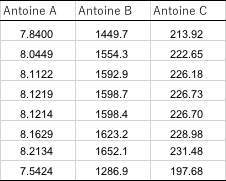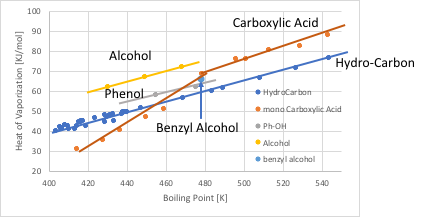2024.9.04
Chemistry at pirika.com > Chemistry > Chemical engineering > Reprint: gas-liquid equilibrium estimation by ASOG. >
Chapter 3: Problems with the ASOG Method
As we have seen, it is very easy to estimate the vapour-liquid equilibrium with the ASOG method and to use the calculated activity coefficients. Simply select the solvent (done by a human), select the parameters from the database (done by a computer), calculate the convergence of temperatures when the composition is changed (done by a computer) and output the results. Of course, the computer is very good at performing a series of calculations while changing solvent pairs one after another and, for example, if there is azeotropy, it can list all the estimated values for azeotropic composition and temperature.
However, it can only be applied if two things are done
ととAntoine定数は純成分データベースに登録されている。
グループ間相互作用パラメータaklはASOGパラメータデータベースに登録されている。
The vjFH and vki and Antoine constants are registered in the pure component database.
The group interaction parameter akl is registered in the ASOG parameter database.
The essential difficulty is the second question of whether the group interaction parameters have been determined. If the solvent you want to know about, for example a group in a CFC substitute compound (e.g. CF3), is not in the database, you cannot do the calculation (or it will be ignored with akl=0).
The ASOG method is also a type of analytical group solution theory. According to group solution theory, it assumes that ‘the contributions of one group in a molecule are assumed to be independent of the contributions of the other groups in that molecule and the principle of additivity can be applied’. There are in fact cases where ‘the contributions of other groups are not independent of each other’ and additivity may not hold.
vjFH is easy because it is the number of heavy atoms, but there is insufficient study on how to count vki.
The ratio of 1:1:0.8:0.5 for CH3-, -CH2-, >CH- and >C< was analysed by Kojima & Tochigi and found to be the best value. It should have many applications for other groups, but in practice it has not been used except for the counting of water to 1.6.
The accuracy would be further improved if, for example, the counting of double bonds introduced into cyclic structures, double bonds attached to aromatics and double bonds attached to nitriles could be generalised, but such studies have not been carried out.
These two problems can be described as problems with the parameter determination method of the ASOG method. A survey of various books shows that there is little information on the parameter determination method of the ASOG method. To the extent that the parameters were determined using the simplex method, the Marcato method, etc., to minimise the error between the experimental value and the estimated value. When we asked Dr Tochigi about the actual parameter determination method, he replied: ‘Parameters are determined collectively by visiting Dr Gmeling (famous for the UNIFAC method). The biggest problem with the ASOG method is that only ‘a very limited number of experts can determine the parameters in a special environment’.
There are also problems with the Antoine constant.
When determining the parameters of the ASOG method, accurate measurements of the vapour-liquid equilibrium are collected from various papers and databases. In such papers, the Antoine constants of the pure substances in the measured system are given. However, such Antoine constants are not always constant.
The values of the Antoine constant for ethanol in the author’s collection of data on vapour-liquid equilibrium are summarised in the following table.

You will see that different Antoine constants are used for the same ethanol. The activity coefficients calculated from measured gas-liquid equilibrium data cannot be reproduced without the Antoine constant used at that time: which value is correct to use for a system containing ethanol to be estimated by the ASOG method?
Various values, such as the Antoine constant of water, have also been published. Essentially, the Antoine constant is a specified temperature range for vapour pressure measurements.
For example, how many is the Antoine constant when analysing vapour pressure data from 0°C to the boiling point of 100°C?
When data from 50°C to 150°C is analysed, it is determined as how many, and so on.
The experimental value of the Antoine constant will naturally vary depending on the boiling point of the counterpart for which the vapour-liquid equilibrium with ethanol is being measured. However, if the ASOG method is to be used based solely on the molecular structure of the pure components, the problem remains that the Antoine constant must be fixed to one value. It should be understood that the accuracy of the ASOG method using a fixed value is inevitably lower than the accuracy described in books and papers. If that is the key material, just change the values in the database.
The issue of intergroup independence has been recognised in the past, but no effective steps have been found.
When calculating the Small Wilson12 parameters for logKow in 2.3.5, we noted that the results for benzyl alcohol did not match. Benzyl alcohol has the structure Ph-CH2-OH. Divided into groups, this gives ArCH(6), CH2(1) and OH(1), where OH is chosen to be the same OH as ethanol, for example. However, the OH of benzyl alcohol is largely a property of the aromatic attribute ArOH. This means that when the molecule is broken apart, the group is not independent of the group to which it was connected.
The same applies to halogenated carboxylic acids such as CCl3COOH and CF3COOH: CCl3COOH, pKa=0.51, CHCl2COOH, pKa=1.26, CH2ClCOOH, pKa=2.87, CH3COOH, pKa=4.76, and the acid dissociation constants (pKa) vary greatly depending on what is attached to the carboxyl group. The acid dissociation constants (pKa) differ greatly depending on what is attached to the carboxyl group.
When the latent heat of evaporation is plotted against the boiling point of a compound, normal solvents ride a straight line. This is known as Trouton’s law. As the molecules get larger and the boiling point gets higher, the latent heat of evaporation increases accordingly and thus rides on a straight line. Such solvents are called regular solutions. In contrast, solvents such as alcohols and carboxylic acids, which form hydrogen bonds, have a higher latent heat of evaporation to the extent that hydrogen bonds are broken.

Two small molecules of carboxylic acid make a dimer. So carboxylic acids are not linear and have bending points. Phenolic hydroxyl groups do not make very strong hydrogen bonds, so the increase in latent heat of evaporation is smaller than for chain alcohols. Benzyl alcohol should be classified as a phenolic ArOH because the relationship between boiling point and evaporation latent heat is close to that of phenol. Thus, the independence between groups is impaired by the greater or lesser electron-withdrawing properties of the groups. To reflect this in the programme, the Troutone Factor, which is the latent heat of evaporation divided by the boiling point, is very important. Also for the network structure of hydrogen bonds, especially for carboxylic acid dimers, there is little prospect of increasing the association constant and so on. It may be necessary to estimate the association constant from the Troutone Factor. In the future, this will be reflected in the counting of vki. This version does not address the issue of independence between groups.
Copyright pirika.com since 1999-
Mail: yamahiroXpirika.com (Replace X with @.)
The subject line of the email should start with [pirika].
